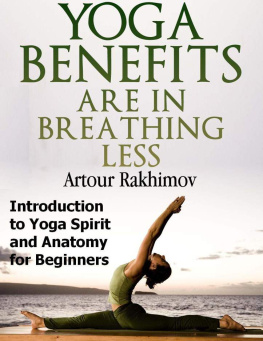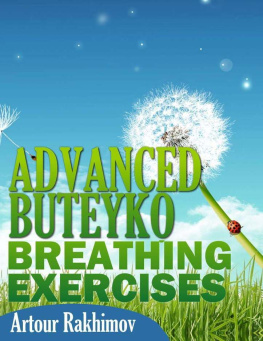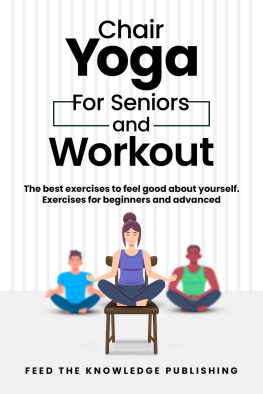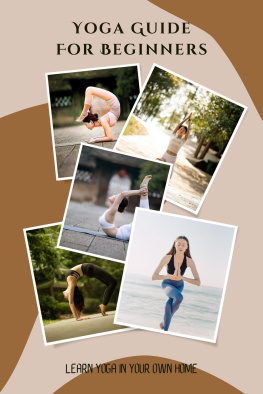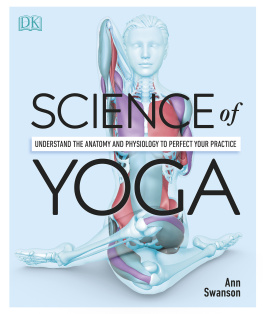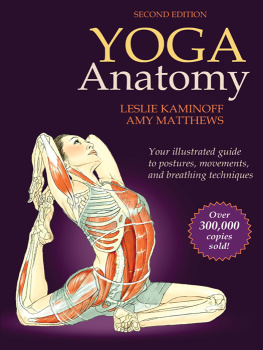Artour Rakhimov - Yoga Benefits Are in Breathing Less: Introduction to Yoga Spirit and Anatomy for Beginners
Here you can read online Artour Rakhimov - Yoga Benefits Are in Breathing Less: Introduction to Yoga Spirit and Anatomy for Beginners full text of the book (entire story) in english for free. Download pdf and epub, get meaning, cover and reviews about this ebook. year: 2012, genre: Romance novel. Description of the work, (preface) as well as reviews are available. Best literature library LitArk.com created for fans of good reading and offers a wide selection of genres:
Romance novel
Science fiction
Adventure
Detective
Science
History
Home and family
Prose
Art
Politics
Computer
Non-fiction
Religion
Business
Children
Humor
Choose a favorite category and find really read worthwhile books. Enjoy immersion in the world of imagination, feel the emotions of the characters or learn something new for yourself, make an fascinating discovery.
- Book:Yoga Benefits Are in Breathing Less: Introduction to Yoga Spirit and Anatomy for Beginners
- Author:
- Genre:
- Year:2012
- Rating:4 / 5
- Favourites:Add to favourites
- Your mark:
Yoga Benefits Are in Breathing Less: Introduction to Yoga Spirit and Anatomy for Beginners: summary, description and annotation
We offer to read an annotation, description, summary or preface (depends on what the author of the book "Yoga Benefits Are in Breathing Less: Introduction to Yoga Spirit and Anatomy for Beginners" wrote himself). If you haven't found the necessary information about the book — write in the comments, we will try to find it.
You can eat tons of supplements and super-foods, drink canisters of herbal drinks, have hundreds of colonic irrigations, and practice yoga for many hours every day, but if your body oxygen level remains the same, you will suffer from the same symptoms and require the same dosage of medication. You can also have years of spiritual practices while getting sicker and sicker with cancer, diabetes or some other condition.
Only 2-3 generations ago, yoga did cure chronic diseases. Old American health journals from the 1920s and 30s were full of advertisements of yoga courses with money back guarantees. Those yoga courses were for people with asthma, hypertension, chronic fatigue, insomnia and other common conditions. And old yoga gurus could provide their pupils numerous yoga benefits in weeks or, at most, in months because they knew one yoga secret. Millions of people restored their health with old, traditional yoga.
The main yoga benefit relates to better body oxygenation or correct automatic breathing. If you get this yoga benefit, all other benefits will follow. Then you can get an astonishing level of energy, perfect digestion, excellent sleep, and greatly improved physical fitness.
Why could modern yoga teachers not replicate the same success? What is wrong or different in contemporary yoga leaders and their teaching? Why most yoga courses provide almost no yoga benefits?
Modern yoga teachers cannot explain, in exact numbers, the ideal breathing pattern that provides maximum body O2 levels. What do they say? Most yoga teachers claim that we need to breathe more air (even at rest) and expel toxic CO2.
Modern science testify about solid physiological foundation of ancient yoga: when we breathe more air at rest (hyperventilation), we have less O2 in body cells. Breathing more air does not increase blood oxygenation to any significant degree. A person can breathe twice less or several times more than the medical norm, but blood oxygenation will be about the same, or about 97-99 %. But CO2 is the crucial factor for O2 transport. The book explains why slow and small breathing (with more CO2) provides more O2 for the cells.
Thousands of recent research studies have proven beyond all doubts that chronic health problems, on a cell level, are based on low O2 levels. This relates to heart disease, cancer, diabetes, obesity, arthritis, inflammatory conditions, cystic fibrosis, HIV-AIDS and many other conditions. You cannot have normal body oxygenation and a lifestyle disease. Therefore, freedom from diseases is among main yoga benefits.
There are also hundreds of research studies that measured breathing of healthy people, ordinary people and people with chronic diseases. Dozens of these studies and their exact results are quoted in this book. These studies testify about the triumph of ancient yoga and its benefits.
Deep breathing, as during pranayama, only looks deep. In reality, pranayama should be done with maximum breath holds and accumulation of CO2 in order to have slower breathing after the practice and 24/7. Only with progress in pranayama, one can get main yoga benefits. These discoveries belong to Dr KP Buteyko, a leading Soviet physiologist and the author of the famous Buteyko breathing method.
Progress in yoga can be measured using a simple DIY body-oxygen test that is described in this book. If you get over 40 seconds of O2 for this easy test, then you will be astonished with changes in your health and real
Artour Rakhimov: author's other books
Who wrote Yoga Benefits Are in Breathing Less: Introduction to Yoga Spirit and Anatomy for Beginners? Find out the surname, the name of the author of the book and a list of all author's works by series.

